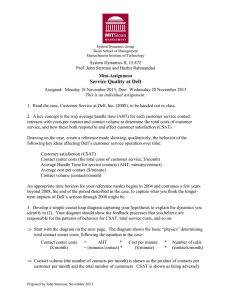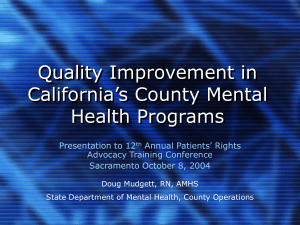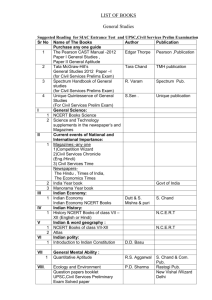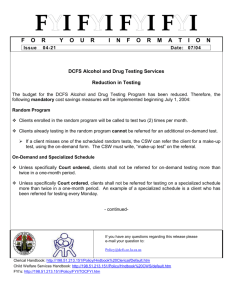Checklist for Successful CSAT/Implementation
advertisement
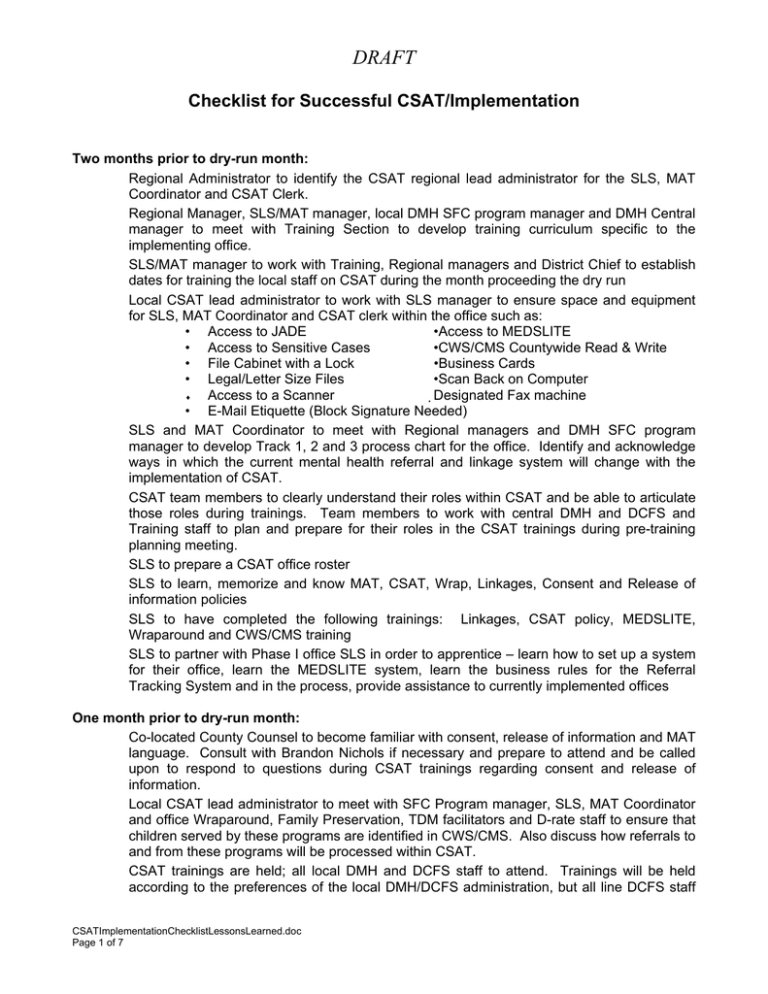
DRAFT Checklist for Successful CSAT/Implementation Two months prior to dry-run month: Regional Administrator to identify the CSAT regional lead administrator for the SLS, MAT Coordinator and CSAT Clerk. Regional Manager, SLS/MAT manager, local DMH SFC program manager and DMH Central manager to meet with Training Section to develop training curriculum specific to the implementing office. SLS/MAT manager to work with Training, Regional managers and District Chief to establish dates for training the local staff on CSAT during the month proceeding the dry run Local CSAT lead administrator to work with SLS manager to ensure space and equipment for SLS, MAT Coordinator and CSAT clerk within the office such as: • Access to JADE •Access to MEDSLITE • Access to Sensitive Cases •CWS/CMS Countywide Read & Write • File Cabinet with a Lock •Business Cards • Legal/Letter Size Files •Scan Back on Computer ♦ Access to a Scanner Designated Fax machine • E-Mail Etiquette (Block Signature Needed) SLS and MAT Coordinator to meet with Regional managers and DMH SFC program manager to develop Track 1, 2 and 3 process chart for the office. Identify and acknowledge ways in which the current mental health referral and linkage system will change with the implementation of CSAT. CSAT team members to clearly understand their roles within CSAT and be able to articulate those roles during trainings. Team members to work with central DMH and DCFS and Training staff to plan and prepare for their roles in the CSAT trainings during pre-training planning meeting. SLS to prepare a CSAT office roster SLS to learn, memorize and know MAT, CSAT, Wrap, Linkages, Consent and Release of information policies SLS to have completed the following trainings: Linkages, CSAT policy, MEDSLITE, Wraparound and CWS/CMS training SLS to partner with Phase I office SLS in order to apprentice – learn how to set up a system for their office, learn the MEDSLITE system, learn the business rules for the Referral Tracking System and in the process, provide assistance to currently implemented offices One month prior to dry-run month: Co-located County Counsel to become familiar with consent, release of information and MAT language. Consult with Brandon Nichols if necessary and prepare to attend and be called upon to respond to questions during CSAT trainings regarding consent and release of information. Local CSAT lead administrator to meet with SFC Program manager, SLS, MAT Coordinator and office Wraparound, Family Preservation, TDM facilitators and D-rate staff to ensure that children served by these programs are identified in CWS/CMS. Also discuss how referrals to and from these programs will be processed within CSAT. CSAT trainings are held; all local DMH and DCFS staff to attend. Trainings will be held according to the preferences of the local DMH/DCFS administration, but all line DCFS staff CSATImplementationChecklistLessonsLearned.doc Page 1 of 7 DRAFT and support staff to attend. DMH SFC staff and DCFS CSAT staff shall attend several sessions to respond to questions and articulate their roles to line staff. Make up training session(s) shall also be scheduled. During the “Dry-run” month: Any/all assignments made to SLSs by the Regional administration in addition to their CSAT responsibilities stop. Regional Administration to make the first monthly CSAT assignment to line staff by the 3rd of the month (dry-run begins on the 1st of the month) to be due by the 18th of the month. This assignment requires that henceforth, all newly non-detained children (track 2) receive a MHST, that the MHST is forwarded to the CSAT in-box, and that if the MHST is positive, a DCFS 174 and DCFS 179 PHI and DCFS MH are attached. Monthly Case Plan Report (available on the Site) are to be used to identify children on current open cases (track 3) who have case plan updates due. DMH will identify which of these children are currently receiving MH services. Those not currently receiving MH services will need to have a MHST completed by the CSW. If the MHST is positive, a DCFS 174 and DCFS 179 PHI and DCFS 179 MH are attached to the MHST. SLS and MAT Coordinators are to begin entering all cases due that month into the RTS. This data will not be reported to the BOS for the dry-run month, but will count towards CSAT implementation efforts. SLS/MAT/CSAT Clerk to create a filing system for Negative MHSTs, Active MHSTs, Referral Coversheet transmittal to DMH, Pending Files, and filing of Track 2 & 3 Cases by SCSW DMH and DCFS CSAT staff to begin meeting once per week to exchange case specific information for service linkage, individual case and systemic trouble shooting and to compare DMH and DCFS logs to insure consistency of data. SLS will conduct in-service trainings within unit and/or section meetings in order to address questions in a smaller setting to reinforce and operationalize CSAT procedures for line staff First Month of Implementation and thereafter: SLS/MAT/DCFS SFC staff to continue to conduct in-service trainings as needed and/or requested In cases transferred from one DCFS office to another, the originating office will continue to be responsible for MHST, assessment and linkage to service until the case becomes a track 3 case. CSAT teams and co-located staff will consult with each other to insure that children are linked to appropriate services with local providers. DCFS MAT/SLS and DMH SFC meet weekly to exchange DMH activity start and open episode dates and to cross reference logs and insure that staff is receiving timely feedback regarding MH service linkage for all referred children. DCFS MAT/SLS and DMH SFC staff meet centrally periodically in order to insure program fidelity and to receive updated RTS and training information Monthly Meetings with DCFS/DMH Administrative Meeting to discuss CSAT Concerns following Implementation CSATImplementationChecklistLessonsLearned.doc Page 2 of 7 DRAFT HOW TO IMPLEMENT CSAT (FROM LESSONS LEARNED) Pre-Implementation Activities • Central DMH, CSAT and Training staff will meet with the Regional Administrator and/or their designated staff to discuss models, dates and locations for CSAT training for Regional staff. This meeting is intended to address office specific needs and preferences in light of other programmatic needs currently being addressed within the Regional office. The offices with the most successful implementation have had Regional Administrators, District Chiefs and their direct subordinates actively involved and supportive of the CSAT process. Support from the office heads is crucial to the engagement of line staff and support staff within the office such as TDM facilitators, Family Preservation, Wraparound, PHNs, Educational Liaisons, Out-stationed County Counsels, etc. who need to work around and within the CSAT process. • SLS staff will work with other support staff to map the office’s current mental health service delivery process and, through negotiations within the office, adapt that process to the CSAT process in a manner that is the least disruptive to line operations and acknowledges areas of operational strength within the office. Although there are policies and “non-negotiables that come with CSAT, there are also enough significant variations within SPAs that require a “customized” version of CSAT for each office. • Regional and District Administrators, as well as DMH SFC and DCFS CSAT team members will be participating actively in training activities with the line staff, therefore they need to participate actively in pre-implementation activities in order to understand their roles, and those of their colleagues and subordinates within the CSAT process. • The “dry-run” month that precedes actual implementation follows the month spent in pre-implementation activities and staff training. In practice, the dry-run looks just like actual implementation; the only difference is that the results of the referral tracking system (RTS) are not released to the Board of Supervisors. Regular meetings are required between DCFS and DMH managers as well as DCFS and DMH CSAT members during this dry-run in order to work out procedural shortcomings and to trouble-shoot potential barriers to success within the office. Implementation Issues • Regional Administrators, Central CSAT Administration and District Chiefs need to anticipate and plan together for adequate CSAT staffing. CSAT staff that are on leave affect the ability to complete screening and service linkage if there is a lack of back up staff. In addition, Emergency Response (ER) Children’s Social Worker (CSW) vacancies have caused delays in the Medical Hub and Multi-disciplinary Assessment Team (MAT) referral process. The successful implementation of CSAT in each regional office is directly correlated to the strength of the team. Strong teams have been shown to meet regularly; case conferencing occurs formally and informally; data CSATImplementationChecklistLessonsLearned.doc Page 3 of 7 DRAFT entry occurs regularly; and systems are in place to manage exigent circumstances with little disruption. Similarly, the screening and referral process is more efficient and comprehensive in offices completing upfront Team Decision-Making meetings on all new cases. Phase I regional offices with thriving CSAT teams and processes will be used as models for Phase II offices. Additionally, the number of Suspected Child Abuse Referrals received and newly open cases completed each month by a particular office impacts staff participation rates. • “Bottlenecks” in the flow of referrals to DMH co-located staff and to DMH MAT providers from DCFS can be prevented or reduced when Central CSAT administration is made aware of CSAT staff absences by Regional Administration. When the work flows at a steady pace, DMH staff and DMH MAT providers are able to ensure timely processing, even in high volume offices. However, the referral process can be stalled due to the unexpected absence of any key CSAT staff member. When Central program administration is notified, alternative staff is assigned and the back log of referrals is processed quickly, creating an abundance of referrals difficult to manage at the same time. Back-up staffing plans for SLS, MAT Coordinators, and Screening Clerks are necessary to ensure steady workflow. • Regional Administration should anticipate that SLS staff in Phase II offices will be sent to Phase I offices during pre-implementation activities. The workload related to data collection and input for Track #3: Existing Cases is one of the greatest challenges in the initial implementation of CSAT. The Departments find that certain aspects of the CSAT process are under-resourced and have explored options to compensate. Newly hired Phase II CSAT staff will learn by “apprenticing” to support implementation in Phase I Service Planning Areas (SPAs). In turn, Phase I CSAT staff will support implementation in Phase II SPAs, making for a much smoother transition. • Regional Administrators and District Chiefs should anticipate that when there are high rates of detentions of infants, there may be low rates of screening. The Departments are aware of the difficulty assessing very young children and data seems to reinforce this concern. While DMH is working with providers to build competence in this area, both Departments need to work together to determine the most effective means of increasing the capabilities of all staff to screen very young children. In addition, the Departments intend to research whether the design of the screen adequately identifies “red flags” for infants. • DCFS Regional Managers need to issue a monthly CSAT assignment to their CSWs and SCSWs every month for the first six months of implementation. The SLSs can be called upon to prepare the memo/email on behalf of the RA (see attached). This memo will remind staff to complete the MHST for all newly non-detained children and to review a log provided by the SLS of all children on currently open cases who are to have a case plan update. The CSW is to indicate if the child is currently receiving mental health services. If the child is not receiving mental health services, they are to complete the MHST for that child. Since the MHST is time-sensitive, if the child’s case files indicate that an MHST was completed more than 120 days prior to the due date, CSATImplementationChecklistLessonsLearned.doc Page 4 of 7 DRAFT the CSW is to complete another MHST. A deadline for this task is made in two weeks in order to allow the SLS time to complete their data entries and referral to SFC staff when necessary. • CSW should, during the first 6 months of CSAT implementation, make sure that a MHST is completed for a child whenever the new case plan is created (i.e., the case status changes from FM to FR, detention on a voluntary case, etc.). If a child is or has received MH services within the last 120 days, an MHST is not required, but the SLS needs to be notified of the child’s current participation in MH services. If a worker does these things, the chances of being prompted to do MHSTs on a track 3 child following the first 6 months of implementation should be reduced. Consent: • Consent Forms are proving more difficult than expected to obtain at initial ER CSW contacts – this appears to be the primary reason for delay in completion of referral packets. • CSWs are to obtain consent for mental health services prior to referring a child to DMH. Consent can be obtained from a parent, guardian or a child 12 years of age or older capable of providing informed consent. When consent is not obtained from the parent/legal guardian or child, the CSW must request consent from the court to expedite the child’s linkage to a mental health or developmental assessment. In some instances, the Court does not accept the CSW’s recommendation orders; may neglect to make orders altogether or may overlook signing orders. This delays the service linkage process for days or weeks as the CSW must make additional requests of the Court. The Department has received agreement from county counsel, children’s and parents’ attorneys, and is close to agreement with judicial officers on standardizing the language in the orders the Court makes for mental health services and release of protected health information. The standardized order will ensure uniformity of language and eliminate the need to write individual orders every time consent is requested. Upon agreement on the language by all parties, the Department and Court will agree on a process to ensure orders are completed and signed as requested. Referral Tracking System (RTS)/Technical Issues • During initial CSAT implementation, RTS processes continued to be refined that resulted in changes in practice, affecting the data in the RTS. In July 2009, we finalized our process to ensure DCFS obtained consent prior to making the referral for mental health services. This was a key addition to Katie A. policy developed with the creation of CSAT. As a result, data reflected the rate of referral to mental health services slowing and the rate of mental health service activity increasing. • Technology has presented challenges to the implementation of CSAT in SPA 7, such as developing a system for sharing information between DCFS and DMH, varying levels of technological competence among staff and nearly obsolete hardware. CSATImplementationChecklistLessonsLearned.doc Page 5 of 7 DRAFT • A number of factors influenced the variation in participation rates reflected in the data in the RTS Summary Data Report from the Phase I (SPAs 1, 6, and 7) offices. For Track 1 the disparity was often due to continuity of MAT staff and/or a fluctuation in the number of detentions from one month to another. Differences in office practice may have accounted for inconsistencies in Tracks 2 and 3. Offices that reflected larger rates of mental health services conducted frequent meetings to track case flow and staffing to ensure timely data entry. In contrast, offices that reported lower participation rates are those that tended to process referrals in batches. Instances where there was a large influx of referrals late in the month resulted in the appearance of lower rates of mental health services. Finally, computer down time significantly affected the CSAT staff’s ability to enter data in a timely manner. Remember, the accurate and final reflection of CSAT activities and participation rates requires 90 days from case opening. • The RTS User Guide (found on the Katie A. Website and distributed to CSAT staff) has been refined to reflect more consistent language and clarity. Case examples were added to further clarify directions. Because data entry becomes a series of decision points for the SLS and MAT coordinator, apprenticeship training for Phase II staff should provide the “hands on” training needed to enter data consistently and reflect accuracy in the RTS reports. Barriers to Timely Mental Health Service Delivery • Developing CSW trust and buy-in of system is critical for successful operation of the CSAT process. • Positive screen rates may be lower than expected resulting in fewer children being referred for MH services. Screening results are highly dependent on information available to screener; information available to screener is highly dependent on time involved with case. Screens generated from initial ER CSW contacts are less likely to be positive than screens generated during subsequent TDMs, where information is more plentiful. The initial ER CSW contact appears to represent a challenging situation in which to make screening determinations, or to complete other CSAT processes such as obtaining consent. These issues may be better addressed at a later date, such as at a TDM. Case-carrying CSWs need to be aware of the limitations of initial screenings, and to be prepared to assume the primary MH screening role for the children on their case-loads, regardless of the presence of an initial negative screen. • Timely identification of a child's Medi-Cal eligibility for linkage to all mental health services is important. DCFS received access to MEDSLITE, a state medical insurance eligibility system that allows the CSAT team to quickly determine a child's Medi-Cal status. However, the skills required for rapid benefits establishment remains under development. SLS are identified as the Medi-Cal eligibility experts for the MEDSLITE system and are receiving ongoing training to accomplish this goal. CSATImplementationChecklistLessonsLearned.doc Page 6 of 7 DRAFT • Children in cases transferred into Los Angeles County from another county in California often come with out-of-county Medi-Cal. In order to receive services by a Los Angeles County mental health provider, the children’s Medi-Cal must be converted to Los Angeles County, which can be a time consuming process that delays service linkage. • Individual case circumstances affect the rates of referral and rates of service access. Namely, decreased rates of referral often result from cases closed soon after case opening, children who run away or children who refuse to participate in mental health services. Likewise, the rate of mental health service access is also affected by the type or lack of insurance. Accessing mental health services is challenging for those children without Medi-Cal or for those with private insurance. • Existing Family Preservation Procedures require that linkage to mental health services is initiated at the Multi-Disciplinary Case Planning Committee (MCPC) meetings when the initial case plan is developed with the family by the Family Preservation Lead Agency. This process can delay referrals to mental health services for children in newly opened, non-detained cases. To rectify this situation, the DMH Family Preservation Liaison (DMH Liaison) is completing an expedited contact to determine whether mental health services are needed faster than the current process allows. If so, the DMH Liaison will complete the service linkage and advise the Family Preservation Lead Agency. If the case is not urgent, the DMH Liaison will assist the Family Preservation Lead Agency to link the child to services through the current MCPC process. For example, where the DMH Liaison was integrated into the CSAT process, the children involved with Family Preservation who screen positive are now being triaged as a priority. CSATImplementationChecklistLessonsLearned.doc Page 7 of 7

